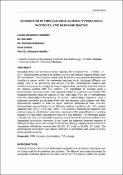Options
Degradation of triclosan from aqueous systems using a photocatalytic membrane reactor
Date issued
2015
Author(s)
Constantin, Lucian Alexandru
Nitoi, Ines
Batrinescu, Gheorghe
Cristea, Ionut
Nechifor, Gheorghe
Abstract
Nowadays there is an increased concern regarding the triclosan (TCS) – 5 chloro – 2 – (2,4 – dichlorophenoxy) phenol persistence, toxicity and potential negative impact upon the environment. TCS is used on a large scale for personal care products fabrication and therefore is present within the wastewater treatment plants discharged effluents and sludge. Due to its persistence and toxicity, UV/TiO2 photocatalysis coupled with membrane processes for catalyst recovery is representing a promising treatment method for aqueous systems with TCS content. The degradation of triclosan using a photocatalytic membrane reactor utilizing photocatalyst in suspension was studied. The proposed treatment sequence consists of two main steps. First one is heterogeneous UV/TiO2 photocatalysis followed by the second - photocatalyst separation using a polymeric membrane and its reuse within the next treatment cycle together with fresh photocatalyst addition in order to assure optimum photocatalyst dose. UV/TiO2 photocatalysis was performed in the following working conditions: pH = 6.5, catalyst optimum dose [TiO2] = 200 mg/L, time t = 90 minutes. Photocatalyst separation was realized using an ultrafiltration polymeric membrane (12% polysulfone) at a working pressure of 2 bars until a concentration ratio of ½ was achieved. The membrane played a double role both in photocatalyst separation and as barrier for remanent pollutant and degradation by-products molecules. It was found that proposed treatment sequence is efficient for five cycles with no need of membrane cleaning / replacement and with TCS degradation efficiency varying from 99.72% (1st cycle) to 93.52% (5th cycle). The photocatalyst consumption was reduced with 52% in comparison with classic UV/TiO2 photocatalysis processes.
Files
Loading...
Name
LC sgem_paper_1.pdf
Size
453.12 KB
Format
Adobe PDF
Checksum
(MD5):ff29482f88a29b59a24f239704e0dc54